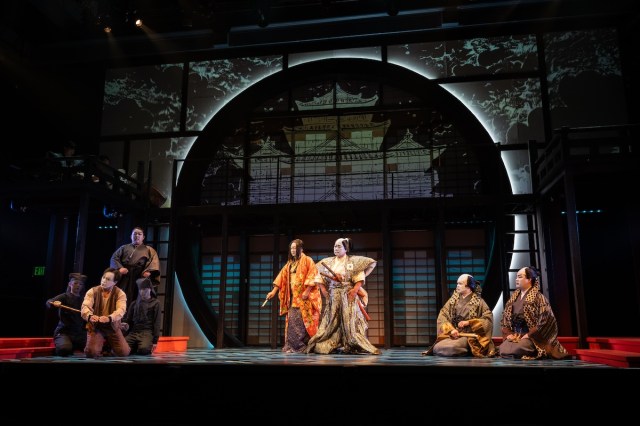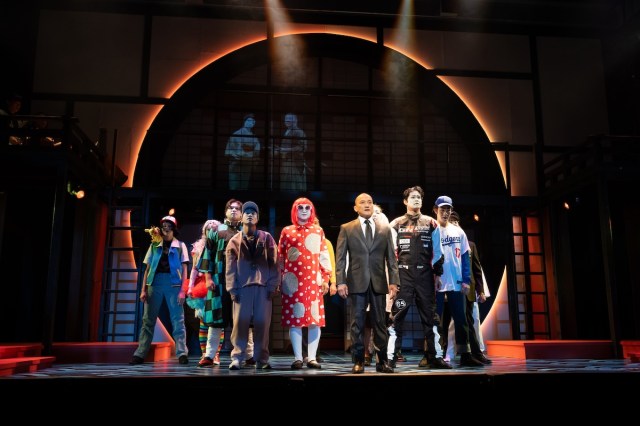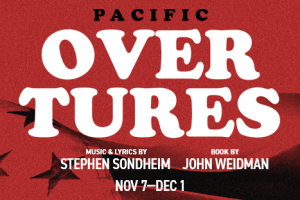Review: Pacific Overtures Gets an Enticing Revival From East West Players
Stephen Sondheim and John Weidman’s musical stars Jon Jon Briones as the Reciter.

(© Teolindo)
When something unique is presented to you, you can either reject it, or absorb its sumptuous foreign flavors. Stephen Sondheim and John Weidman’s Pacific Overtures, so heavily influenced by Japanese culture and Kabuki theater techniques, is a tantalizing treat in which a country is the main character. The East West Players’ revival is like biting into an exotic passion fruit for the first time.
For 250 years, Japan had remained isolated from the entire world. Then, in 1853, US President Filmore sent ships to the island, politely advising — or rather, demanding under threat of attack, — that Japan open trade with the superpower. A reciter (Jon Jon Briones) relays the story of Japan’s exploitation without one shot fired. Once Japan had relented to the USA, it discovers that many other countries — UK, Russia, France, Holland — are “friendlily” invading. Eventually, the unspoiled, remote country becomes a resource for the Western economy.
The book by John Weidman (with additional material from Hugh Wheeler) concentrates on several Japanese players confounded by the American breach: Lord Abe (Kerry K. Carnahan), the Shogun’s adviser who represents the child Emperor and takes more power when the Shogun (also played by Briones) dies; Kayama, a police prefect (Brian Kim McCormick) at the port where the American ships are approaching, who receives a promotion doomed to fail; and Manjiro (Adam Kaokept), a fisherman up for execution because he once abandoned Japan for the US, and whose wiles save his new friend Kayama both politically and literally.
The characters, though only pieces of the puzzle, are absorbing and relatable. There are two oddities in the libretto. First, though there are subtleties in the song “A Bowler Hat,” the deteriorating relationship between two friends comes to an abrupt conclusion as if a scene had been cut. Second, the finale “Next” takes the country from the late 19th century to modern time with satirical bite, but purposely and perplexingly, ignores the traumatic events of World War II and its nuclear finish.

(© Teolindo)
Sondheim’s soaring score incorporates Japanese instruments including a shamisen, Japanese winds, and percussion. The musical numbers begin with sounds found in Kabuki theater and, as the country is raided by the West, the music transforms to a more American style. “Chrysanthemum Tea” is a deceptively pleasing melody, in which a mother (Gedde Watanabe) shows her son mercy by poisoning him. The Western invasion number “Please Hello” rousingly integrates American marches, British operetta, and Russian classicism. “Someone in a Tree” views the meeting between Japan and the US from different perspectives, while “A Bowler Hat” represents the westernization of Japanese loyalists.
Pacific Overtures has a special place in East West Players history. The Broadway production’s star, Mako, was EWP’s co-founder back in 1965. EWP performed the show in 1979, with Mako reprising his Tony-nominated performance, and again in 1998, helmed by the current director Tim Dang.
In this production, Briones guides the audience through the complex story. Watanabe, who co-starred in the original Broadway cast as the boy singing “Someone in a Tree,” provides a beguiling wink during “Chrysanthemum Tea,” and an enigmatic voice while manipulating the puppet child Emperor. Kim McCormick and Kaokept become the heart of the piece as their friendship builds and falters. They are supported by a radiant supporting cast.

(© Teolindo)
Director Dang decorates the production with striking images including traditional make-up and hair by Yoko Haitz. Ornate costumes by Naomi Yoshida feature intriguing masks that give the Western characters a deformed maleficence. David Murakami’s lavish Japanese art projections and Tesha Nakagawa’s mixture of joinery design and shoji doors complete the stunning visuals. Glenn Michael Baker’s puppetry for the aging Emperor is exquisite.
The choreography by Yuka Takara and Kabuki theater consultant Kirk Kanesaka (a.k.a. Gankyō Nakamura) is most striking in the small moments, like Kayama’s wife’s gentle but graphic suicide, and the young geisha’s attack by European sailors. The fight choreography by Amanda Noriko Newman is stylized but gripping. Marc Macalintal’s music direction and conducting richly captures Sondheim’s complex score.
Western imperialism is always timely in a world where xenophobia reigns. What continues to make Pacific Overtures so alive and prescient is how it presents the dilution of culture in a mode both universal and heartrending. Tim Dang and his EWP artists have preserved what made the untouched Japan so remarkable and the journey to modern day so inevitable.









